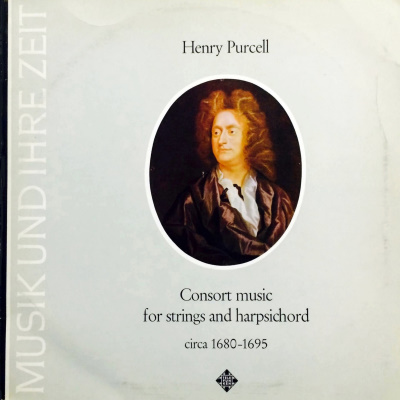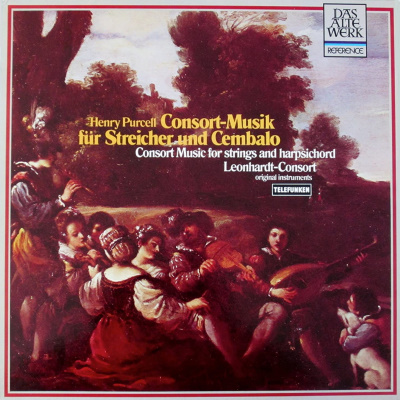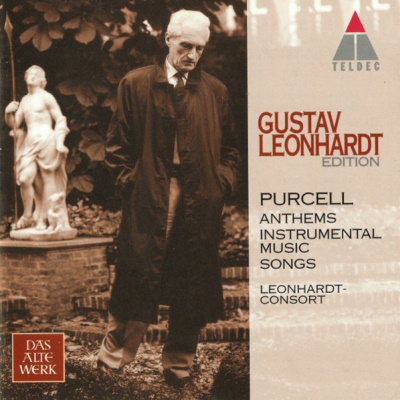 |
|
1 LP -
SAWT 9506-A - (p) 1967
|
 |
| 1 LP -
6.41222 AQ - (p) 1967 |
 |
| 2 CDs -
3984-21768-2 - (c) 1998 |
|
CONSORT MUSIC
FOR STRINGS AND HARPSICHORD
|
|
|
|
|
|
|
|
|
|
| Henry PURCELL (1659-1695) |
Ouverture
in D minor, Z. 771 - 2 violins,
viola & continuo |
|
|
3' 41" |
A1 |
|
Pavan
in B flat, Z. 750 - 2 violins &
gamba |
|
|
3' 11" |
A2 |
|
Ground in D minor, Z. D 222
- "Crown the altar" from "Celebrate the
festival"
|
Harpsichord |
|
2' 00" |
A3 |
|
Overture
(with Suite) in G, Z. 770 - 2
violins, viola & continuo - (Overture · Air · Bourrée ·
Menuet · Air · Jigg) |
|
|
7' 36" |
A4 |
|
Pavan
in A minor, Z. 749 - 2 violins &
gamba |
|
|
3' 38" |
A5 |
|
Fantasia
(Chaconne): Three parts on a ground in D,
Z. 731 - 3 violins & continuo |
|
|
4' 37" |
A6 |
|
Ouverture
in G minor, Z. 772 - 2 violins, 2
violas & continuo |
|
|
3' 33" |
B1 |
|
Suite
in D, Z. 667 - (Prelude · Almand
· Hornpipe)
|
Harpsichord |
|
4' 37" |
B2 |
|
Pavan
of Four Parts in G minor, Z. 752 - 3
violins & gamba |
|
|
4' 33" |
B3 |
|
Sefauchi's
Farewell (in D minor), Z. 656 |
Harpsichord |
|
1' 12" |
B4 |
|
A
New Ground (in E minor), Z. T 682 -
"Here the deities approve" from "Welcome
to all pleasure"
|
Harpsichord |
|
2' 37" |
B5 |
|
Sonata
in A minor, Z. 804 - (1697, III) - 2
violins & continuo
|
|
|
6' 02" |
B6 |
|
|
|
|
|
|
The Z. numbers refer to the
catalogue of Purcell's works by Zimmermann
|
|
|
|
|
|
|
|
|
|
|
LEONHARDT
CONSORT with original instruments
- Marie Leonhardt, violin
(Jacob Stainer, Absam, 1676)
- Antoinette van den Hombergh, violin
(Klotz, Mittenwald, 18th century)
- Sigiswald Kuyken, violin
(Jan Boumeester, Amsterdam 1683) and
gamba (William Addson, London circa
1670)
- Wim ten Have, viola
(Giovanni Tononi, 17th century)
- Lodewyk de Boer, viola
(German 18th century)
- Dyck Koster, violoncello
(Giovanni Battista [II] Guadagnini,
1749)
- Gustav Leonhardt, harpsichord
(Rainer Schütze, Heidelberg 1961) &
gamba
Gustav LEONHARDT, Direction
|
|
|
|
|
|
Luogo
e data di registrazione |
|
Hervormde Kerk,
Bennebroek (Holland) - 10/12
Aprile 1967
|
|
|
Registrazione: live
/ studio |
|
studio |
|
|
Producer |
|
Wolf Erichson
|
|
|
Prima Edizione LP |
|
Telefunken "Das Alte
Werk" | SAWT 9506-A (Stereo) - AWT
9506-A (Mono) | 1 LP - durata 47'
16" | (p) 1967 | ANA
Telefunken
"Reference" | 6.41222 AQ | 1 LP
- durata 47' 16" | (p) 1967 |
ANA | Riedizione
|
|
|
Edizione CD |
|
Teldec Classics |
LC 6019 | 3984-21768-2 | 2 CDs -
durata 50' 30" - 60' 53" | (c)
1998 | ADD |
|
|
Cover
|
|
"Henry Purcell",
painting by Closterman. National
Gallery, London.
|
|
|
Note |
|
-
|
|
|
|
|
The Overture
in D minor, like most of
Purcell’s works with this
title, is an overture of the
French type, such as Charles
II’s exiled court society
would often have heard in
Versailles. The slow
introduction spices the
consistently dotted rhythm
with melodic and harmonic
chromaticism and constant
concealment of the cadences.
The following Allegro in 6/4
time combines the principles
of the French overture,
which prescribe a fugato for
this section, with the
English tradition of the
consort-canzona, in which
two different themes are
treated in canon, one after
the other. The closing
Andante refers back to the
introduction in rhythm and
tempo, but introduces a new
motif which retains its
individuality and its
melancholy, resigned
expression through Purcell’s
favourite downward leap of
the diminished fifth.
The Pavane in B flat major
probably belongs to
Purcell’s earliest works
and, like the other pavanes
on our record, was very
likely composed before 1680.
Its relationship to the
English consort tradition is
obvious; the first section
is full and proceeds
placidly, led by a nobly
melancholy melody; the
second part is more lively,
with a canzona rhythm,
strongly chromatic both in
melody and harmony and thus
more emotional.
The Ground (i. e. ostinato)
in D minor is the adaptation
for harpsichord of an aria
from the birthday ode for
Queen Mary Crown the
altar, deck the shrine,
which Purcell had written in
1693. The layout of the
movement, which builds up a
clear da capo form over a
five-bar ground bass
repeated thirteen times,
corresponds to this origin.
With its writtenout
arpeggios in the left hand
and its graceful little
ornaments, the small piece
is written with great
elegance, entirely in the
spirit of the virginalists
of the Golden Age.
The Overture to the suite in
G major follows the French
model more faithfully than
the D minor Overture, in
that after the slow
introduction it introduces
only one fugal theme - one
of the lively, near-dance
triadic themes which Purcell
loved. The following Air is
also stamped with triadic
melodies, but with those of
the high baroque sarabande
with its noble, broad
melodic arches, which later
only Handel was to write so
simply and yet so
intensively as Purcell. The
Bourrée is at first sight a
completely “French” movement
of courtly refinement, but
at the ends of the lines
with their stressed repeated
crotchets Purcell’s
affection for his native
folk music surprisingly
breaks through the elegant,
unruffled surface,
noticeably and amusingly.
Even the very concise and
simple Menuet with its
cheerful syncopations has
something of this delightful
mixture of court and rustic
spheres. An Air, just as
concise and serious, is
finally followed by a wholly
English Jigg - not a French
Gigue - in 6/4 time, with
wide intervals and a wittily
accentuated, again almost
robustly rustic rhythm.
The Pavane in A minor is far
more artistic and more
intense in expression than
the B flat Pavane. The first
of the three main parts,
almost unbrokenly for tutti
and with the stress on the
melody, is permeated with
intense chromaticism, which
in the less rigid second
part, imitative of a
concertante, grows even
stronger in chromatically
rising lines, downward
diminished fifths and
surprising cadences. The
third part introduces a
melodically new imitation
theme, which in rhythm
however harks back to the
second part, and from a
chromatically rising bass
line culminates in a
splendid final cadence.
Even more clearly than in
this piece, which by all
traditional standards is
unusually expressive,
Purcell’s early mastery
shows itself in the
large-scale Fantasia in D
major, which is a “fantasia
on a ground”, and therefore
a chaconne and perhaps
(likewise originating from
before 1680) the first of
the great chaconnes for
which, in instrumental as in
vocal music, Purcell was to
be special famous. The short
four-bar ostinato motif is
stated 28 times, though it
is really no more than a
traditional cadence pattern
(the celebrated Romanesca
bass); above this is
unfolded a movement for
three voices of deliberate
diversity which culminates
in a splendid ending, which
intensifies the
sarabande-like inflexion of
the opening by means of
scintillating major-minor
alternations and seemingly
exhausted, sighing, sinking:
motifs, and which thus
forges the link back to the
beginning of the gigantic
movement, which for all the
artistry of the outline
unfolds with no apparent end
in view.
The five-part Overture in G
minor, with which the second
side of our record begins,
is probably also an early
work. The Allegro section,
rather like that in the D
minor Overture, is built up
as a canzona from several
fugal motifs; the closing
Adagio, despite its
shortness, lays powerful
emphasis on the end by means
of strongly chromatic
harnionic movement above two
pedal-points - here, as
everywhere in the young
Purcell’s works, it is above
all the harmony whose
boldness and dark,
characteristically
mournfully-tinted
magnificence of colour
leaves far behind it all the
conventions of the forms he
had taken over, and presses
forward to the most personal
expression.
Somewhat lighter than the
large ensemble pieces is the
small F minor Suite for
harpsichord, composed in
1689, in whose three terse
movements are mirrored the
playing techniques of the
earlier virginalists, as is
also their fondness for
sublimating folk-music
elements (to be found here
in the spirited Hornpipe).
The four-part Pavane in G
minor unfolds like the A
minor Payane, into a concise
ternary form, but with an
even more subtly
contrapuntal art and even
greater intensity of
expression.
Sefauchi’s Farewell
is an elegiac little Menuett
in D minor, which was in all
probability written for the
departure from England (in
1688) of the celebrated
castrato Giovanni Francesco
Grossi, who had received the
nickname “Siface”.
More impressive, in
comparison with this
harmless but delicate
miniature, is the New
Ground in E minor, the
arrangement made in 1689 of
an aria from probably the
first Ode to St. Cecilia by
Purcell, Welcome to all
the pleasures (1683).
Over the “ground”, a
threebar chromatic cadence
in changing guise, an
elegant melody develops in
the upper parts, alternating
between cantabile and
ornamental sections. Here,
within a small framework and
with more modest means, he
moulds and balances the art
of constructing his
movements with elegance of
form and subtlety of
expression, as in the great
D major Chaconne.
Finally, the A minor
trio-sonata is an example of
the sovereignty with which
Purcell adopted the
representative form of the
“modern” Italian chamber
music of his time. The work
is the third of the
posthumous collection of
sonatas of 1697, but was
perhaps written very much
earlier, at the time of the
first trio-sonatas (around
1683); Roger North’s
judgment of Purcell’s
trio-sonatas confirms it
fully as “clog’d with
somewhat of an English
vein”, but yet, and for that
very reason, “very
artificiall and good
Musick”. The form of the
work still corresponds
exactly to that of the early
Italian sonata: a
canzona-like series of short
sections, of which only the
last has a pronounced dance
character. “Somewhat of an
English, vein” is
nevertheless easy to
recognise: in the harmonic
intensity of the first Grave
and of the third section; in
the connection of a delicate
cantabile quality tinged
with a little melancholy and
subtlety of construction, in
the second section (Largo,
3/4); in the strict
counterpoint of the
“canzona” and even of the
closing Gigue with its
combinations and inversions
of themes, which, as in the
glorious period of consort
music, are quite obviously
moulded spontaneously into a
harmonically rich and
naturally flowing style of
writing; finally in the
cadence of the Grave with
its chromatic
intensification so typical
of Purcell’s construction at
the end of a movement. This
sonata too, like nearly all
of Purcell’s instrumental
music, is “very artificiall”
- but like everything that
the “Orpheus Britannicus”
wrote, it is also “very good
Musick”.
····················
Henry
Purcell’s Instrumental
Music
In the composition of the Orpheus
Britannicus the
instrumental music, in
quantity, is of almost
negligibly small importance
compared with the sacred and
secular vocal works, yet in
quality occupies a place
which is all the more
significant. The composer’s
position between epochs, his
intimate contact with the
English tradition along with
his resistance to new
influences penetrating from
the Continent, his
historical key position as
the successor of the Golden
Age of English music, and
yet his solitary greatness -
nowhere can these be more
clearly seen than in the
handful of purely
instrumental compositions,
which mainly belong to his
earliest creative years: in
the three- and four-part
fantasias for consort of
viols without continuo, in
which the 21-year-old
Purcell took his leave in
1680 of the great tradition
of English consort music; in
the trio sonatas published
three years later, in which
the new style of the Italian
sonata with continuo had
already, to a large extent,
supplanted the polyphonic
consort technique; in the
small occasional pieces for
harpsichord, which brought
back to life, transformed,
the great artistry of the
virginalists; and in the
overtures, suites and single
dance movements for strings,
which form the link between
consort music and the great
stage music of later years.
Purcell’s youth coincided
with the early years of the
Restoration, and his
creative years until his all
too early death in 1695 at
the age of 36 with the full
blossoming of London’s
metropolitan and court
musical life under Charles
II (1660-85), James II
(1685-89) and William III
(1689-1702). The Golden Age
of English music, with its
extensive yet fastidiously
refined musical culture of
court, nobility and
land-owning middle-class had
foundered in the chaos of
civil war; the short but
intensive blooming of
instrumental ensemble music
for consort, of the art of
virginals-playing and of the
lute-song did not survive
the economic crisis of the
twenty years of the civil
war and Cromwell’s
Commonwealth. When Charles
II and his court society
were re-established in 1660,
the scene in England had
changed irrevocably, and the
predilections which the new
trend-setting society of
immigrants brought with them
made a simple link with the
musical traditions of the
Golden Age impossible in any
social restoration. The
place of a widespread
musical culture, judged to
be sound and upheld by a
broad range of musicians,
was taken on the one hand by
music as a social and court
manifestation after the
model of Versailles, and on
the other (on which modern,
i. e. fashionable musical
life increasingly
concentrated) by music as an
entertainment for the
general public of the
metropolis of London,
musically no longer very
fastidious, and scarcely
conscious of tradition. The
place of the indigenous,
serious and phlegmatic
polyphony of consort music
was taken by the new and
simpler Italian sonata,
melodically and harmonically
more obvious; that of the
lute-song, subtle both in
text and in music, by the
popular dance-song and
sociable song; and the place
of music-making by small
circles of connoisseurs and
music-lovers was
increasingly taken by public
concerts given by
professionals and travelling
virtuosi - mostly from Italy
- and by musico-dramatic
stage performances intended
for a wide public to enjoy,
preferably merely passively.
In these circumstances
Purcell’s consort fantasias
of 1680 were really already
an anachronism. This
exercise in writing by a
rising musician was in an
idiom which the public had
long regarded as antiquated
- it is significant that
Purcell’s works were not
printed during his lifetime,
and that the autograph
clearly shows how the
composer finally dropped his
original ambitious plan for
a large collection of
fantasias. But in fact even
the small group of completed
three- and four-part
movements grew, in the hands
of a genius, into a splendid
culmination of a species,
into the combination of the
traditional strictly
contrapuntal structure with
a new, emotionally highly
charged and harmonically
bold musical language, which
put in the shade even the
greatest models from the
beginning of the century.
Directly after this
“traditional” beginning,
however, Purcell seems to
have turned decisively to
the fashionable and
forward-looking instrumental
forms of his time. In the
trio sonatas published in
1683 and dedicated to
Charles II (followed in 1697
by a second collection
published by his widow) he
had, in the words of the
preface, “faithfully
endeavour’d a just imitation
of the most fam’d Italian
Masters”. The strict art of
the viol consort is still
perceptible throughout these
first “endeavours”, but from
now on the Italian basso
continuo and the Italian
sound of the violin remain
the bases of his
instrumental composition -
transformed, admittedly,
into a highly personal
idiom. Its wholly
superficial elegance yet
melodic intensity,
complicated but vital rhythm
and bold harmony are as
impossible to mistake as the
unique recasting of the
Italian song style into a
declamatory and vocal
technique, developed
entirely from the English
language, which a little
later begins to appear in
his first big vocal works.
Purcell never became
“Italian” like so many of
his lesser contemporaries
and as the musical taste of
the court he served would
have urged. His greatness
lies in the very fact that
he remained “original”, that
he did not make concessions
to the musical tendencies of
his time but converted them
to suit himself. The
fantasias and sonatas of
1680 and 1683 are documents
of a spiritual biography, in
which the greatest composer
of his time and country came
to terms with the past and
present and expressed
himself freely. Since it was
a genius who in them trod
this double path of
development, they are at the
same time valid works of
art, to which clings nothing
immature or primarily
experimental, just as in the
smaller instrumental works
from the same or a later
period, which he himself did
not send to be printed, and
of which the present record
includes an important part.
Ludwig
Finscher (translated
by Lionel Salter)
|
  |
|
|